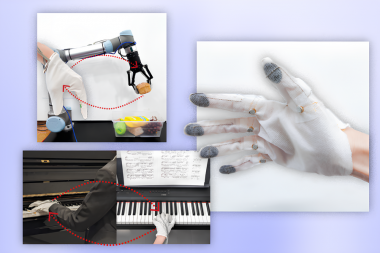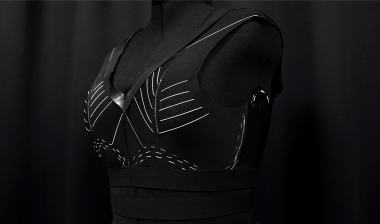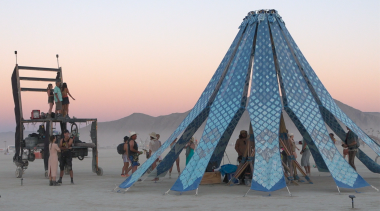The 4D Knit Dress - Is this the future of fashion?
Developed by the Self-Assembly Lab, the 4D Knit Dress uses several technologies to create a custom design and a custom fit, while addressing sustainability concerns.
Until recently, bespoke tailoring — clothing made to a customer’s individual specifications — was the only way to have garments that provided the perfect fit for your physique. For most people, the cost of custom tailoring is prohibitive. But the invention of active fibers and innovative knitting processes is changing the textile industry.
“We all wear clothes and shoes,” says Sasha MicKinlay MArch ’23, a recent graduate of the MIT Department of Architecture. “It’s a human need. But there’s also the human need to express oneself. I like the idea of customizing clothes in a sustainable way. This dress promises to be more sustainable than traditional fashion to both the consumer and the producer.”
McKinlay is a textile designer and researcher at the Self-Assembly Lab who designed the 4D Knit Dress with Ministry of Supply, a fashion company specializing in high-tech apparel. The dress combines several technologies to create personalized fit and style. Heat-activated yarns, computerized knitting, and robotic activation around each garment generates the sculpted fit. A team at Ministry of Supply led the decisions on the stable yarns, color, original size, and overall design.
“Everyone’s body is different,” says Skylar Tibbits, associate professor in the Department of Architecture and founder of the Self-Assembly Lab. “Even if you wear the same size as another person, you're not actually the same.”
Active textiles
Students in the Self-Assembly Lab have been working with dynamic textiles for several years. The yarns they create can change shape, change property, change insulation, or become breathable. Previous applications to tailor garments include making sweaters and face masks. Tibbits says the 4D Knit Dress is a culmination of everything the students have learned from working with active textiles.
McKinlay helped produce the active yarns, created the concept design, developed the knitting technique, and programmed the lab’s industrial knitting machine. Once the garment design is programmed into the machine, it can quickly produce multiple dresses. Where the active yarns are placed in the design allows for the dress to take on a variety of styles such as pintucks, pleats, an empire waist, or a cinched waist.
“The styling is important,” McKinlay says. “Most people focus on the size, but I think styling is what sets clothes apart. We’re all evolving as people, and I think our style evolves as well. After fit, people focus on personal expression.”
Danny Griffin MArch ’22, a current graduate student in architectural design, doesn’t have a background in garment making or the fashion industry. Tibbits asked Griffin to join the team due to his experience with robotics projects in construction. Griffin translated the heat activation process into a programmable robotic procedure that would precisely control its application.
“When we apply heat, the fibers shorten, causing the textile to bunch up in a specific zone, effectively tightening the shape as if we’re tailoring the garment,” says Griffin. “There was a lot of trial and error to figure out how to orient the robot and the heat gun. The heat needs to be applied in precise locations to activate the fibers on each garment. Another challenge was setting the temperature and the timing for the heat to be applied.”
“We couldn’t use a commercial heat gun — which is like a handheld hair dryer — because they’re too large,” says Griffin. “We needed a more compact design. Once we figured it out, it was a lot of fun to write the script for the robot to follow.”
A dress can begin with one design — pintucks across the chest, for example — and be worn for months before having heat re-applied to alter its look. Subsequent applications of heat can tailor the dress further.
Beyond fit and fashion
Efficiently producing garments is a “big challenge” in the fashion industry, according to Gihan Amarasiriwardena ’11, the co-founder and president of Ministry of Supply.
“A lot of times you'll be guessing what a season's style is,” he says. “Sometimes the style doesn't do well, or some sizes don’t sell out. They may get discounted very heavily or eventually they end up going to a landfill.”
“Fast fashion” is a term that describes clothes that are inexpensive, trendy, and easily disposed of by the consumer. They are designed and produced quickly to keep pace with current trends. The 4D Knit Dress, says Tibbits, is the opposite of fast fashion. Unlike the traditional “cut-and-sew” process in the fashion industry, the 4D Knit Dress is made entirely in one piece, which virtually eliminates waste.
“From a global standpoint, you don’t have tons of excess inventory because the dress is customized to your size,” says Tibbits.
McKinlay says she hopes use of this new technology will reduce the amount of waste in inventory that retailers usually have at the end of each season.
“The dress could be tailored in order to adapt to these changes in styles and tastes,” she says. “It may also be able to absorb some of the size variations that retailers need to stock. Instead of extra-small, small, medium, large, and extra-large sizes, retailers may be able to have one dress for the smaller sizes and one for the larger sizes. Of course, these are the same sustainability points that would benefit the consumer.”
The Self-Assembly Lab has collaborated with Ministry of Supply on projects with active textiles for several years. Late last year, the team debuted the 4D Knit Dress at the company’s flagship store in Boston, complete with a robotic arm working its way around a dress as customers watched. For Amarasiriwardena, it was an opportunity to gauge interest and receive feedback from customers interested in trying the dress on.
“If the demand is there, this is something we can create quickly” unlike the usual design and manufacturing process, which can take years, says Amarasiriwardena.
Griffin and McKinlay were on hand for the demonstration and pleased with the results. For Griffin, with the “technical barriers” overcome, he sees many different avenues for the project.
“This experience leaves me wanting to try more,” he says.
McKinlay too would love to work on more styles.
“I hope this research project helps people rethink or reevaluate their relationship with clothes,” says McKinlay. “Right now when people purchase a piece of clothing it has only one ‘look.’ But, how exciting would it be to purchase one garment and reinvent it to change and evolve as you change or as the seasons or styles change? I'm hoping that's the takeaway that people will have.”
Massachusetts Institute of Technology MIT Self-Assembly Lab 4D Knit Dress knitting
Maria Iacobo | Olivia Mintz | School of Architecture and Planning, MIT Department of Architecture





